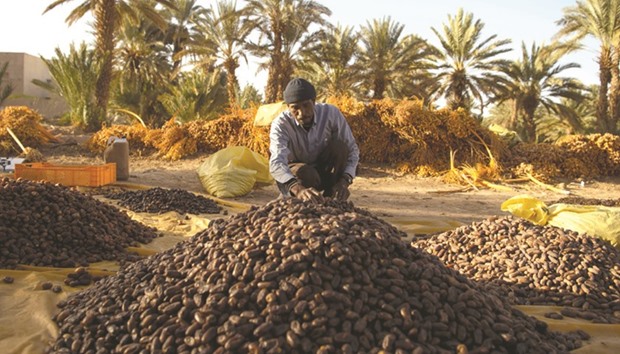On the edge of the southwestern town of Rissani, Abdelrahman Ahmidani sighs as he reflects on the state of the Moroccan oasis, endangered by drought and climate change.
“Whoever lives here,” he says, “is condemned to a life of poverty.”
In Rissani, the sinuous mountain oasis of Tafilalet gradually disappears into the Sahara desert, after snaking green for dozens of kilometres down the Ziz valley.
The town, the tourist pamphlets say, was where Morocco’s ruling family established itself in the 17th century and was once a major crossroads — famous for gold trade — on ancient merchant routes to Senegal and Sudan.
But since the 1980s, the sands have been advancing on the town.
On the outskirts of Rissani, hundreds of palm tree trunks rot away on cracked ochre soil shot through with parched irrigation channels.
“When I was a child, the oasis was green and thriving. In one generation, it has become almost completely dry and sterile,” says 37-year-old Ahmidani, who grew up in Rissani and now works as an official in town.
The late 20th century brought long periods of drought, leading farmers to flee the area abandoning their earthen houses to dissolve whipped up in sandy winds.
“Oases are part of Morocco’s natural resources,” Ahmidani says of the green sanctuaries that for centuries have formed a shield against desertification.
But mismanagement of surface water and overexploitation of groundwater — notably due to urbanisation — has led to increasing drought. Morocco has lost a third of its oases in a century.
About 20km outside Rissani, Hassan Sadok has been working on rehabilitating seven hectares of land for the past 15 years.
“Date palms are a natural barrier against desertification,” says the former hotel owner turned farmer for lack of tourists.
“In the beginning everyone laughed at me,” he said.
“The land was dry and sterile, and growing anything in it was very difficult.
“Look over there. Those lands are dead.
“But on my farm, thanks to my date palms, the land is fertile. My farm turns a profit and is environmentally friendly.”
Sadok rears sheep for their dung and refuses to use industrial fertilisers.
He also pumps groundwater using solar power and tries not to overconsume it.
Clear water runs between his 1,800 date palms, while plaited reed barriers hold back the desert beyond.
“Oases withstand drought much better with these ancient methods,” says Ali Oubarhou, who is in charge of oasis areas at the agriculture ministry.
Rabat launched an ambitious project to revive its oases in 2008 as part of the “Green Morocco” plan, he says.
After the number of date palms dropped nationwide from 15mn a century ago to just 4.8mn, it has now increased back to 6.6mn trees — with a goal of 8mn date palms in 2020.
Oases are the most vulnerable ecosystems to climate change, according to the UN intergovernmental panel on climate change, and their disappearance comes at heavy environmental, economic, social and cultural cost.
Rabat will be presenting an action plan to save the world’s oases at an international climate conference it is hosting this month.
It will unveil a proposal for a “sustainable oasis” at the COP22 climate talks to run in Marrakesh on November 7-18.
Bringing back date cultivation means “generating wealth to create areas that are attractive to people, all the while preserving natural heritage through a rational use of resources and preserving biodiversity”.
“But we have to be realistic,” Oubarhou says, explaining action at local level will not be enough. “We will need international cooperation to save the oases, and we’re expecting a lot out of COP22.”

A Moroccan harvests dates at a farm near Morocco’s southeastern oasis town of Erfoud, north of Rissani in the Sahara Desert.
